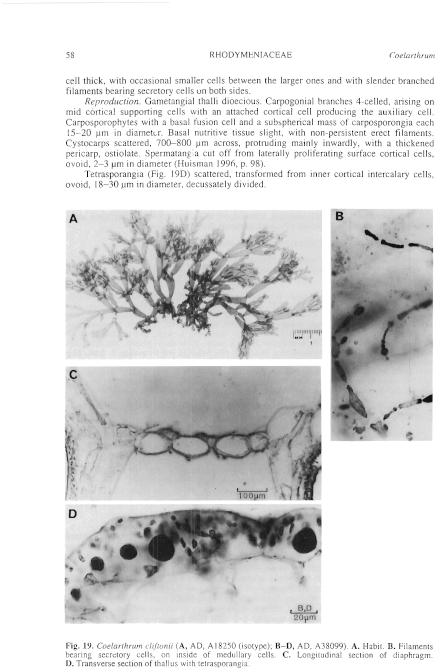|
|
|
|
|
|||||||||||
|
Electronic Flora of South Australia Species Fact Sheet
Phylum Rhodophyta – Class Florideophyceae – Order Rhodymeniales – Family Rhodymeniaceae
Selected citations: Huisman 1996: 96, figs 1–15. Huisman & Walker 1990: 415. May 1965: 361. Norris 1986: 537, figs 1–5(?).
Synonyms
Chylocladia cliftonii Harvey 1855a: 556; 1858: pl. 57. Sonder 1881: 17.
Erythrocolon cliftonii (Harvey) J. Agardh 1876: 302; 1896: 91. De Toni 1900b: 584.
Chylocladia tenera J. Agardh 1896: 87, nom. nudum.
Thallus (Fig. 19A) medium red to red-brown, fading to yellow-red, 5–20 cm high, much branched radially to 3 or 4 orders, with percurrent main axes or branches, laterals and lesser branches progressively shorter. All branches segmented, branches arising irregularly from the upper half of each segment, with occasional anastomoses, segments hollow, elongate ovoid, increasing in size from the branch apices, 1–3 (–4) cm long and 3–6 mm in diameter near the thallus base; constrictions very short in length and 0.5–1.5 mm broad. Holdfast discoid, epilithic or on solid substrata. Structure multiaxial, with a cortex 20–30 µm and 1–2 cells thick, outer cells laxly arranged, often in slight rosettes, ovoid and 4–6 µm in diameter, changing abruptly to a large-celled medulla 1–2 cells thick bordering the central weakly mucilaginous cavity, with the inner cells ovoid and 90–250 µm in diameter, walls 3–8 µm thick with some secondary pit-connections and bearing branched filaments (Fig. 198) from initials on the inner medullary cells which cut off ovoid secretory cells 7–14 µm in diameter. Rhodoplasts discoid, in chains in inner cells. Constrictions with partitions (Fig. 19C) one cell thick, with occasional smaller cells between the larger ones and with slender branched filaments bearing secretory cells on both sides.
Reproduction: Gametangial thalli dioecious. Carpogonial branches 4-celled, arising on mid cortical supporting cells with an attached cortical cell producing the auxiliary cell. Carposporophytes with a basal fusion cell and a subspherical mass of carposporangia each 15–20 µm in diameter. Basal nutritive tissue slight, with non-persistent erect filaments. Cystocarps scattered, 700–800 µm across, protruding mainly inwardly, with a thickened pericarp, ostiolate. Spermatangia cut off from laterally proliferating surface cortical cells, ovoid, 2–3 µm in diameter (Huisman 1996, p. 98).
Tetrasporangia (Fig. 19D) scattered, transformed from inner cortical intercalary cells, ovoid, 18–30 µm in diameter, decussately divided.
Type from Fremantle, W. Aust. (Clifton); lectotype (Tray. Set 265) in Herb. Harvey, TCD. Isolectotypes in MEL, 502097 and AD, A18250.
Selected specimens: Egg I., Isles of St Francis, S. Aust., 35 m deep (Shepherd, 7.i.1971; AD, A38099). Pearson I., S. Aust., 30–32 m deep (Shepherd, 7.i.1969; AD, A33692). Off Troubridge I., S. Aust., 23 m deep (Shepherd, 4.ii.1969; AD, A33812). Vivonne Bay, Kangaroo I., S. Aust., 0–3 m deep (Kraft & Min-Thein, 4.xii.1971; AD, A41412).
Distribution: Montebello Is, W. Aust., to Troubridge I., S. Aust., and Vivonne Bay, Kangaroo I., S. Aust.
Canary Is; Natal, Mauritius; West Indies; Indonesia (see Huisman 1996, p. 96).
Taxonomic notes: C. cliftonii was based on Harvey's Tray. Set 265 which was not located in TCD in 1952. A Clifton specimen in TCD (Alg. Aust. Exsicc. 425a) is chosen as lectotype.
Chylocladia tenera J. Agardh is based on a single specimen of Harvey (or Clifton), named C. cliftonii by Harvey, in Herb. Agardh, LD, 25822.
Norris (1986, fig. 1), followed by Huisman (1996, p. 96) recorded C. cliftonii from South Africa, but his description differs from C. cliftonii in the description of tetrasporangia ("borne on inner cortical cells") and in the apparent presence (Norris fig. 5) of rows of small cells lying in the angles of the large medullary cells.
References:
AGARDH, J.G. (1876). Species Genera et Ordines Algarum. Vol. 3, Part 1 — Epicrisis systematis Floridearum, pp. i-vii, 1–724. (Weigel: Leipzig.)
AGARDH, J.G. (1896). Analecta Algologica. Cont. III. Acta Univ. lund. 32, 1–140, Plate 1.
DE TONI, G.B. (1900b). Sylloge Algarum omnium hucusque Cognitarum. Vol. 4. Florideae. Sect. 2, pp. 387–776. (Padua.)
HARVEY, W.H. (1855a). Some account of the marine botany of the colony of Western Australia. Trans. R. Ir. Acad. 22, 525–566.
HARVEY, W.H. (1858). Phycologia Australica. Vol. 1, Plates 1–60. (Reeve: London.)
HUISMAN, J.M. & WALKER, D.I. (1990). A catalogue of the marine plants of Rottnest Island, Western Australia, with notes on their distribution and biogeography. Kingia 1, 349–459.
HUISMAN, J.M. (1996). The red algal genus Coelarthrum. Børgesen (Rhodymeniaceae, Rhodyméniales) in Australian waters. Phycologia 35, 95–112.
KYLIN, H. (1931). Die Florideenordnung Rhodyméniales. Lunds Univ. Årsskr. N.F. Avd. 2, 27 (11), 1–48, Plates 1–20.
MAY, V. (1965). A census and key to the species of Rhodophyceae (red algae) recorded from Australia. Contr. N.S.W. natn. Herb. 3, 349–429.
NORRIS, R.E. (1986). Coelarthrum (Rhodymeniaceae, Rhodophyceae), a genus new to southern Africa. S. Afr. J. Bot. 52, 537–540.
SONDER, O.W. (1881). In Mueller, F., Fragmenta Phytographiae Australiae. Supplementum ad volumen undecinum: Algae Australianae hactenus cognitae, pp. 1–42, 105–107. (Melbourne.)
The Marine Benthic Flora of Southern Australia Part IIIB complete list of references.
Publication:
Womersley, H.B.S. (28 June, 1996)
The Marine Benthic Flora of Southern Australia
Rhodophyta. Part IIIB. Gracilarialse, Rhodymeniales, Corallinales and Bonnemaisoniales
Reproduced with permission from The Marine Benthic Flora of Southern Australia Part IIIB 1996, by H.B.S. Womersley. Australian Biological Resources Study, Canberra. Copyright Commonwealth of Australia.
Illustration in Womersley Part IIIA, 1996: FIG. 19.

Figure 19 enlarge
Fig. 19. Coelarthrum cliftonii (A, AD, A18250 (isotype); B–D, AD, A38099). A. Habit. B. Filaments bearing secretory cells, on inside of medullary cells. C. Longitudinal section of diaphragm. D. Transverse section of thallus with tetrasporangia.

|
Email Contact: State Herbarium of South Australia |

|